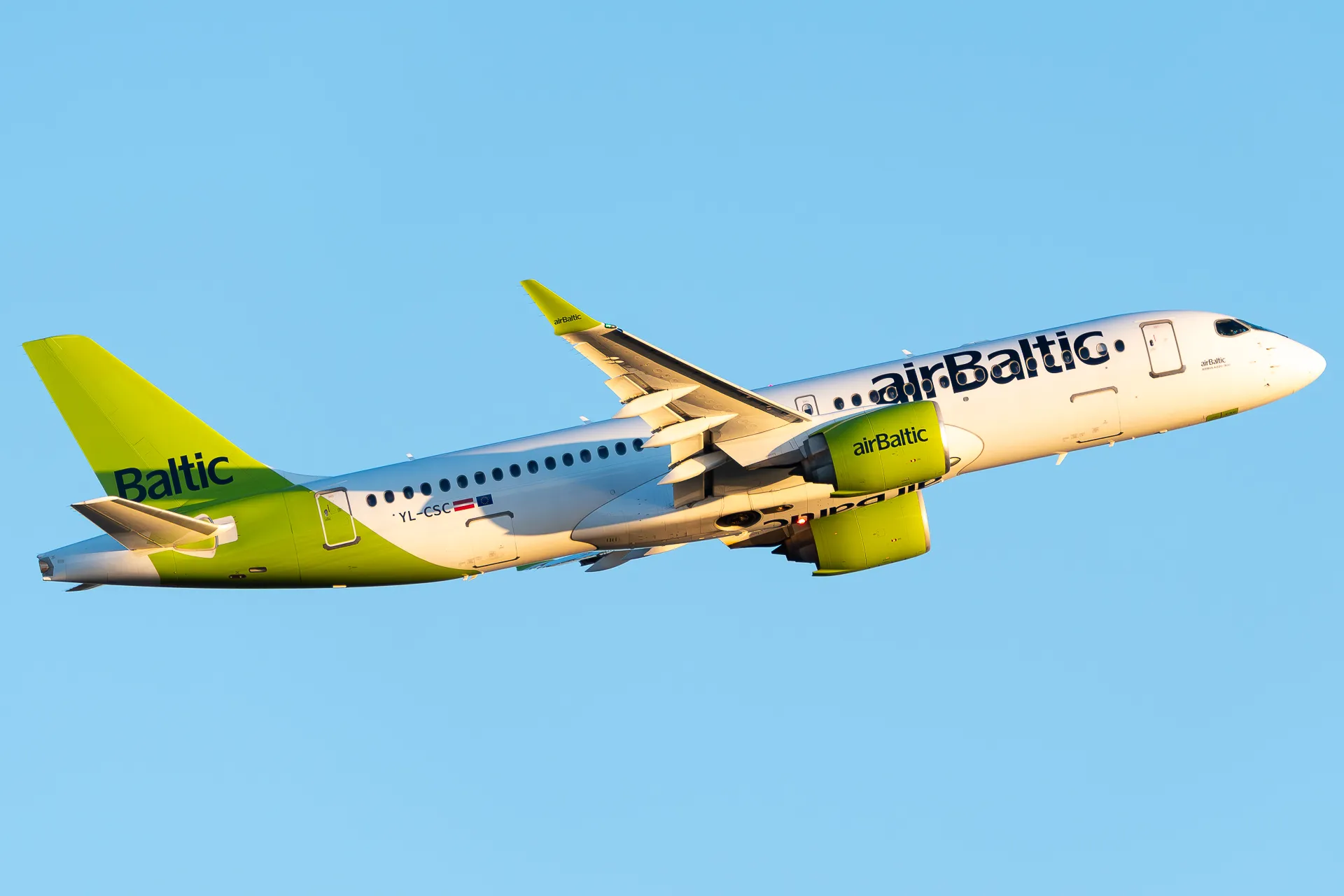RIGA — Latvian airline airBaltic (BT) today announced Q2 2025 as well as 2025 half-year results. Despite cost inflation and macroeconomic challenges in key markets, the airline shows signs of improvement and preserves a positive outlook for the future.
“The results of the first half of 2025 show the resilience of our operations and the consistent demand for our services, as well as the reliability we have ensured in our operations. Even with ongoing challenges – including engine availability and cost pressures – the company sustained stable performance and continued to grow. These results confirm the strength of our business model and our role as a key provider of connectivity in the Baltics and beyond,” said Pauls Cālītis, Interim CEO and COO of airBaltic.
Q225 Highlights
The 2nd quarter of 2025 showed strong performance and has driven the company's recovery.
Antitrust review for Lufthansa Group investment has been positively completed in June 2025, making an essential step towards transaction closing, expectedly in August 2025.
The new CEO selection process is expected to be completed within the next few weeks.
Financial Performance
In Q2 2025, airBalic generated €217 million in revenue, which is almost 5% higher compared to Q2 2024. ACMI-out revenue was up by 5.9% year-on-year.
Earnings Before Interest, Taxes, Depreciation, Amortization, and Restructuring or Rent costs (EBITDAR) decreased by € 4.2 million year-on-year, reaching €55.2 million.
The airline’s reported profit increased by almost €52 million compared to Q2 2024, reaching €27.6 million. The market environment is improving, albeit at a slower pace than expected. Real GDP in Estonia and Latvia contracted in Q1; however, Q2 showed signs of growth.
Cost inflation was driven mainly by outside factors and negatively reflected on airBaltic's profit margins. Negative Management EBITDAR gap showed strong improvement - € 16.4 Millions in Q1 2024 vs € 2.5 Million in Q2 2025
Current booking trends indicate EBITDAR is expected to improve in the second half of 2025.
The IPO has been postponed until next year, and the airline will operate under a cash conservation network during the winter season 2025-2026.
airBaltic ended Q2 2025 with €29 million in cash and plans to raise an additional €50-60 million in Q3 2025.
Operational Performance, Passenger Satisfaction
airBaltic has operated 22,831 flights in Q2 2025, which is 4.5% more compared to Q2 2024; 12,575 of them were within airBaltic’s own 129 routes.
The number of total passengers increased by over 8% reaching 2.5 million, 1.4 million of them were carried across airBaltic's network.
Despite engine availability issues, the airline demonstrated its ability to maintain stable and punctual operations, achieving a 77.9% 15-minute punctuality rate and a 99.6% regularity rate.
The average ACMI-out fleet has reached a record 19 aircraft in Q2. Aircraft were leased out to Swiss, Lufthansa, Austrian Airlines, and Brussels Airlines.
Airlines’ NPS was 59, compared to EU airlines' average of 33. Increased customer satisfaction was driven by Starlink Internet, available on 14 aircraft in the airBaltic fleet. NPS on ACMI-in operations was lower than on airBaltic's own-operated flights.
airBaltic's market share in its main Baltic hubs has shown steady growth, with the airline ranking #1 in Riga (57%) and Tallinn (30%), and #2 in Vilnius (14%).
Q2 showed significantly improved passenger yields (ticket + ancillary yield EUR per passenger) approaching last year’s level after challenging Q1, driven by a significant improvement in load factor.
Three ACMI-in aircraft were utilized in Q2 2025 to meet the growing demand.
H12025 Highlights
Despite a challenging start to the year, Q2 positively impacted the results of H1 2025, showing the airline's ability to navigate a difficult environment.
Financial Performance
- airBaltic recorded all-time highest revenue in H1 of € 350 Million, 3% higher year-on-year.
- EBITDAR decreased by almost €26 million, reaching €50.9 million in H1 2025.
- The airline made significant improvements compared to H1 2024, reducing its loss from €88.7 million to just €1.6 million.
- Cash flow has shown a steady increase in both Q1 and Q2 in 2025 compared to 2024.
Operational Performance
- In H1 2025, airBaltic operated 36,381 flights and carried 3.9 million passengers, 2.4 million of them on airBaltic's flights.
- The airline increased its ACMI-out fleet, which was 12.5 aircraft on average during H1 2025, driven mainly by strong Q2 results.
- Passenger yields dropped in Q1 2025, affecting total performance in H1 2025, yet Q2 showed improvement and reasons to believe for further improvement in the future.
Pratt & Whitney Engine Shortage Stabilizes
P&W engine shortage showed improvement signs with the average time on wing (ATOW) increased. The current engine shortage situation is in line with forecasts supporting positive outlooks for the future.
The average number of Aircraft On Ground (AOG) in Q2 2025 was nine compared to 13 in Q1 2025 and 6 in Q2 2024, with the minimum number of AOGs expected in the Summer of 2026.
Reliable forecasts on engine shortages enable adequate planning for ACMI-in requirements, which should not exceed three aircraft.
Fleet Growth
The updated aircraft delivery schedule is being finalized; the future fleet size remains unchanged, with 100 aircraft to be in the airBaltic fleet in 2031/2032.
In 2025, two aircraft are scheduled to be delivered to airBaltic and five more in H1 2026, based on signed agreements with lessors. With increased engine availability and additional aircraft, available capacity is expected to grow by 25% in 2026.
airBaltic confirmed that the airline's current strategy and business plan focus on Airbus A220-300 aircraft and a single-type fleet.
RASK vs CASK
RASK in Q2 2025 increased by 3.4% year-on-year due to increased demand and an effective pricing policy. Yet, it is still below 2023 levels, showing a relatively weaker macroeconomic situation in key markets. ASK on BT’s networks increased by 0.9% limited by AOGs.
Several exogenous factors, including carbon emission allowances, government and ground fees, and crew and maintenance costs, negatively impacted CASK. Main areas of steep cost escalation are higher Eurocontrol fees, navigation charges, maintenance costs, and crew wages.
The airline did not provide an exact estimation on when RASK might exceed CASK; however, it mentioned that opening in Eastern markets such as Ukraine could boost RASK’s increase.
Increased Fuel, CO2 Emission Costs
While RASK remains at 2015-2019 levels, fuel costs per ASK have risen by 30% reaching 1.9 cents in Q2 2025.
Q2 fuel average fuel price was USD 685 per tonne, 17% less compared to Q2 2024, with 6% of fuel in 2025 hedged at USD 650 per tonne.
CO2 costs in H1 rose by 37% in free emission allowances, showing the EU’s plan to phase out free emission allowances. By the end of April, almost 24% of 2024 emissions were hedged at an average of € 65.9 per tonne with a total unhedged exposure of 262,000 tonnes in 2024.
Liquidity Inflow Project for Q3 2025
Additional €50-60 million in liquidity is expected to be generated from new asset financing (new hangar and P&W engines), €14 million in investment from Lufthansa Group, and potential investment from Lithuania in airBaltic.
Generated cash and operational revenue are expected to be sufficient to support airBaltic operations until the potential IPO window opens in 2026.
Guidance for the 2025 Full Year
The airline is expected to generate total revenue of €780-800 million in 2025. Capital expenditure is forecasted to be between €100 million and €120 million.
EBITDAR is forecasted to reach € 160-175 million. CO2 emissions and fuel costs could materially influence H2 EBITDAR. Utilizing excessive capacity through ACMI and charters is expected to have a positive influence on revenue and EBITDAR.
The total number of passengers transported on airBaltic routes in 2025 is expected to exceed 5 million. Based on booking trends, demand in H2 2025 is expected to be stronger than in the first half.
“Looking ahead, our focus remains on improving efficiency and operational performance, while preparing the company for long-term opportunities – including a potential IPO. With strong forward bookings, an expanded network, and growing ACMI operations, we are well-positioned for the second half of the year,” said Pauls Cālītis.
Outlook for 2026
Management of airBaltic remains positive towards raising additional equity in 2026. Strengthening macroeconomic factors in the Baltic region support growing demand, while expanding the fleet to 57 aircraft by mid-2026 enables airlines to capitalize on this demand by increasing capacity by 25%.
The airline aims to expand its presence in the ACMI market and grow its customer base to utilize excess capacity during the winter. Strategic cooperation with the Lufthansa group signals positive development in the ACMI business segment and potential for improved connectivity for airBaltic customers.
Eliminating ACMI-in services and equipping all aircraft with Starlink in-flight internet is expected to increase NPS and passenger yields further.
In 2026, BT could call its existing bond and refinance it at a lower cost.




